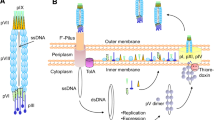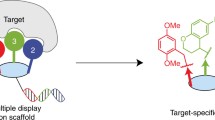Abstract
Thomsen-Friedenreich (TF) antigen occurs on approximately 90% of human carcinomas, is likely involved in carcinoma cell homotypic aggregation, and has clinical value as a prognostic indicator and marker of metastasized cells. Previously, we isolated anti-TF antigen peptides from bacteriophage display libraries. These bound to TF antigen on carcinoma cells but were of low affinity and solubility. We hypothesized that peptide amino acid sequence changes would result in increased affinity and solubility, which would translate into improved carcinoma cell binding and increased inhibition of aggregation. The new peptides were more soluble and exhibited up to fivefold increase in affinity (Kd ≅ 60 nM). They bound cultured human breast and prostate carcinoma cells at low concentrations, whereas the earlier peptides did not. Moreover, the new peptides were potent inhibitors of homotypic aggregation. The maturated peptides will have expanded applications in basic studies of the TF antigen and particular utility as clinical carcinoma-targeting agents.
Similar content being viewed by others
REFERENCES
Bains, R., Furness, P. N., and Critchley, D. R. (1997). J. Pathol. 183: 272–280.
Baldus, S. E., Hanisch, F. G., Kotlarek, G. M., Zirbes, T. K., Thiele, J., Isenberg, J., et al. (1998). Cancer 82: 1019–1027.
Baldus, S. E., Zirbes, T. K., Hanisch, F. G., Kunze, D., Shafizadeh, S. T., Nolden, S., et al. (2000). Cancer 88: 1536–1543.
Barbas, C. F., 3rd, Hu, D., Dunlop, N., Sawyer, L., Cababa, D., Hendry, R. M., et al. (1994). Proc. Natl. Acad. Sci. USA 91: 3809–3813.
Bour-Dill, C., Gramain, M. P., Merlin, J. L., Marchal, S., and Guillemin, F. (2000). Cytometry 39: 16–25.
Brockhausen, I., Schutzbach, J., and Kuhns, W. (1998). Acta Anat. (Basel) 161: 36–78.
Cao, Y., Stosiek, P., Springer, G. F., and Karsten, U. (1996). Histochem. Cell Biol. 106: 197–207.
Chang, C. C., Chen, T. T., Cox, B. W., Dawes, G. N., Stemmer, W. P., Punnonen, J., et al. (1999). Nat. Biotechnol. 17: 793–797.
De Kroon, A. I., Soekarjo, M. W., De Gier, J., and De Kruijff, B. (1990). Biochemistry 29: 8229–8240.
Edge, A. S., and Spiro, R. G. (1987). J. Biol. Chem. 262: 16135–16141.
Fidler, I. J. (1975). Cancer Res. 35: 218–224.
Finne, J., and Krusius, T. (1979). Eur. J. Biochem. 102: 583–588.
Foote, J., and Eisen, H. N. (2000). Proc. Natl. Acad. Sci. USA 97: 10679–10681.
Fridman, R., Giaccone, G., Kanemoto, T., Martin, G. R., Gazdar, A. F., and Mulshine, J. L. (1990). Proc. Natl. Acad. Sci. USA 87: 6698–6702.
Garini, Y., Gil, A., Bar-Am, I., Cabib, D., and Katzir, N. (1999). Cytometry 35: 214–226.
Glinsky, V. V., Glinsky, G. V., Rittenhouse-Olson, K., Huflejt, M. E., Glinskii, O. V., Deutscher, S. L., et al. (2001). Cancer Res. 61: 4851–4857.
Glinsky, V. V., Huflejt, M. E., Glinsky, G. V., Deutscher, S. L., and Quinn, T. P. (2000). Cancer Res. 60: 2584–2588.
Hallahan, D. E., and Virudachalam, S. (1997). Proc. Natl. Acad. Sci. USA 94: 6432–6437.
Horoszewicz, J. S., Leong, S. S., Kawinski, E., Karr, J. P., Rosenthal, H., Chu, T. M., et al. (1983). Cancer Res. 43: 1809–1818.
Inohara, H., and Raz, A. (1995). Cancer Res. 55: 3267–3271.
Jain, R. K. (1989). J. Natl. Cancer Inst. 81: 570–576.
Jessup, J. M., Petrick, A. T., Toth, C. A., Ford, R., Meterissian, S., O'Hara, C. J., et al. (1993). Br. J. Cancer 67: 464–470.
Kim, C., Paulus, B. F., and Wold, M. S. (1994). Biochemistry 33: 14197–14206.
Komissarov, A. A., Calcutt, M. J., Marchbank, M. T., Peletskaya, E. N., and Deutsher, S. L. (1996). J. Biol. Chem. 271: 12241–12246.
Komissarov, A. A., Marchbank, M. T., Calcutt, M. J., Quinn, T. P., and Deutscher, S. L. (1997). J. Biol. Chem. 272: 26864–26870.
Li, G., Satyamoorthy, K., and Herlyn, M. (2001). Cancer Res. 61: 3819–3825.
Li, S., Spear, R. N., and Andrews, J. H. (1997). Appl. Environ. Microbiol. 63: 3261–3267.
Lotan, R., and Raz, A. (1983). Cancer Res. 43: 2088–2093.
Lotan, R., Skutelsky, E., Danon, D., and Sharon, N. (1975). J. Biol. Chem. 250: 8518–8523.
Lundquist, J. J., Debenham, S. D., and Toone, E. J. (2000). J. Org. Chem. 65: 8245–8250.
Luzzi, K. J., MacDonald, I. C., Schmidt, E. E., Kerkvliet, N., Morris, V. L., Chambers, A. F., et al. (1998). Am. J. Pathol. 153: 865–873.
Matarrese, P., Fusco, O., Tinari, N., Natoli, C., Liu, F. T., Semeraro, M. L., et al. (2000). Int. J. Cancer 85: 545–554.
Meromsky, L., Lotan, R., and Raz, A. (1986). Cancer Res. 46: 5270–5275.
Mickey, D. D., Stone, K. R., Wunderli, H., Mickey, G. H., Vollmer, R. T., and Paulson, D. F. (1977). Cancer Res. 37: 4049–4058.
Miller, D. S., Fricker, G., and Drewe, J. (1997). J. Pharmacol. Exp. Ther. 282: 440–444.
Millis, K. K., Lesko, S. A., and Gamcsik, M. P. (1997). Cancer Chemother. Pharmacol. 40: 101–111.
Mummert, M. E., and Voss, E. W. (1996). Mol. Immunol. 33: 1067–1077.
Naureckiene, S., Sleat, D. E., Lackland, H., Fensom, A., Vanier, M. T., Wattiaux, R., et al. (2000). Science 290: 2298–2301.
Panchuk-Voloshina, N., Haugland, R. P., Bishop-Stewart, J., Bhalgat, M. K., Millard, P. J., Mao, F., et al. (1999). J. Histochem. Cytochem. 47: 1179–1188.
Peletskaya, E. N., Glinsky, G., Deutscher, S. L., and Quinn, T. P. (1996). Mol. Divers. 2: 13–18.
Peletskaya, E. N., Glinsky, V. V., Glinsky, G. V., Deutscher, S. L., and Quinn, T. P. (1997). J. Mol. Biol. 270: 374–384.
Raz, A., and Lotan, R. (1981). Cancer Res. 41: 3642–3647.
Saiki, I., Naito, S., Yoneda, J., Azuma, I., Price, J. E., and Fidler, I. J. (1991). Clin. Exp. Metastasis 9: 551–566.
Schmidt, C. M., Settle, S. L., Keene, J. L., Westlin, W. F., Nickols, G. A., and Griggs, D. W. (1999). Clin. Exp. Metastasis 17: 537–544.
Scott, J. K., and Smith, G. P. (1990). Science 249: 386–390.
Smith, R. C., and Lange, R. C. (2001). Crit. Rev. Diagn. Imaging 42: 135–140.
Springer, G. F. (1984). Science 224: 1198–1206.
Springer, G. F., Cheingsong-Popov, R., Schirrmacher, V., Desai, P. R., and Tegtmeyer, H. (1983). J. Biol. Chem. 258: 5702–5706.
Springer, G. F., and Desai, P. R. (1977). Transplant. Proc. 9: 1105–1111.
Springer, G. F., Desai, P. R., and Banatwala, I. (1975). J. Natl. Cancer Inst. 54: 335–339.
Updyke, T. V., and Nicolson, G. L. (1986). Clin. Exp. Metastasis 4: 273–284.
Wang, B. L., Springer, G. F., and Carlstedt, S. C. (1997). J. Histochem. Cytochem. 45: 1393–1400.
Wohland, T., Friedrich, K., Hovius, R., and Vogel, H. (1999). Biochemistry 38: 8671–8681.
Yakushijin, Y., Steckel, J., Kharbanda, S., Hasserjian, R., Neuberg, D., Jiang, W., et al. (1998). Blood 91: 4282–4291.
Yelton, D. E., Rosok, M. J., Cruz, G., Cosand, W. L., Bajorath, J., Hellstrom, I., et al. (1995). J. Immunol. 155: 1994–2004.
Yu, J., and Smith, G. P. (1996). Methods Enzymol. 267: 3–27.
Zucker, R. M., and Price, O. (2001). Cytometry 44: 273–294.
Author information
Authors and Affiliations
Rights and permissions
About this article
Cite this article
Landon, L.A., Peletskaya, E.N., Glinsky, V.V. et al. Combinatorial Evolution of High-Affinity Peptides That Bind to the Thomsen-Friedenreich Carcinoma Antigen. J Protein Chem 22, 193–204 (2003). https://doi.org/10.1023/A:1023483232397
Published:
Issue Date:
DOI: https://doi.org/10.1023/A:1023483232397




